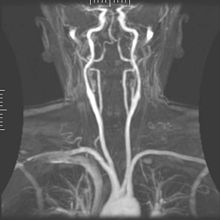 Out of many lab. diagnosis for the internal body structure, MRI is very advance and reliable methods and can give much accurate result also.Nuclear magnetic resonance imaging (NMRI), or magnetic resonance tomography (MRT) is a medical imaging technique used in radiology to visualize the internal structures of the body to investigate both anatomy and function in health and disease. The technique is widely used in hospitals for medical diagnosis, staging of disease and for follow-up. There has been a 10% annual growth in MR usage over the last decade and, although the technique avoids ionizing radiation, there are concerns about cost effectiveness and overdiagnosis.
Out of many lab. diagnosis for the internal body structure, MRI is very advance and reliable methods and can give much accurate result also.Nuclear magnetic resonance imaging (NMRI), or magnetic resonance tomography (MRT) is a medical imaging technique used in radiology to visualize the internal structures of the body to investigate both anatomy and function in health and disease. The technique is widely used in hospitals for medical diagnosis, staging of disease and for follow-up. There has been a 10% annual growth in MR usage over the last decade and, although the technique avoids ionizing radiation, there are concerns about cost effectiveness and overdiagnosis.
MRI has a wide range of applications in medical diagnosis which has led to a substantial increase in its use. Since MRI does not use any ionizing radiation its use should be considered in preference to CT when both modalitites could yield the same information.The safety of MRI during the first trimester of pregnancy is uncertain, but it may be preferable to alternative options. Contraindications to MRI include most cochlear implants and cardiac pacemakers, shrapnel and metallic foreign bodies in the orbits, and some ferromagnetic surgical implants.
2003 Nobel Prize For MRI
Paul Lauterbur of the University of Illinois at Urbana-Champaign and Sir Peter Mansfield of the University of Nottingham were awarded the 2003 Nobel Prize in Physiology or Medicine for their "discoveries concerning magnetic resonance imaging". The Nobel citation acknowledged Lauterbur's insight of using magnetic field gradients to determine spatial localization, a discovery that allowed rapid acquisition of 2D images. Mansfield was credited with introducing the mathematical formalism and developing techniques for efficient gradient utilization and fast imaging. The actual research that won the prize was done almost 30 years before, while Paul Lauterbur was at Stony Brook University in New York.

The award was vigorously protested by Raymond Vahan Damadian, founder of FONAR Corporation, who claimed that he invented the MRI, and that Lauterbur and Mansfield had merely refined the technology. A group called "The Friends of Raymond Damadian" (formed by Damadian's company, FONAR, took out full-page advertisements in the New York Times and The Washington Post entitled "The Shameful Wrong That Must Be Righted", demanding that he be awarded at least a share of the Nobel Prize.
How the Test is done?
1.You may be asked to wear a hospital gown or clothing without zippers or snaps (such as sweatpants and a t-shirt). Certain types of metal can cause blurry images.
2.You will lie on a narrow table, which slides into a large tunnel-shaped scanner.
Some exams require a special dye (contrast). Most of the time, the dye be given through a vein (IV) in your hand or forearm before the test. The dye helps the radiologist see certain areas more clearly.
3.Small devices, called coils, may be placed around the head, arm, or leg, or other areas to be studied. These help send and receive the radio waves, and help the quality of the images.
4.During the MRI, the person who operates the machine will watch you from another room. The test lasts about 30-60 minutes, but may take longer.
Post a Comment